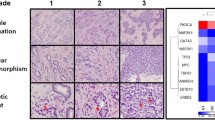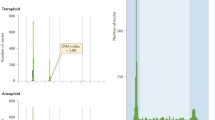Abstract
Pathological grade is a useful prognostic factor for stratifying breast cancer patients into favorable (well-differentiated tumors) and less favorable (poorly-differentiated tumors) outcome groups. The current system of tumor grading, however, is subjective and a large proportion of tumors are characterized as intermediate-grade tumors, making determination of optimal treatments difficult. To determine whether molecular profiles can discriminate breast disease by grade, patterns and levels of allelic imbalance (AI) at 26 chromosomal regions frequently altered in breast disease were examined in 185 laser microdissected specimens representing well-differentiated (grade 1; n = 55), moderately-differentiated (grade 2; n = 71), and poorly-differentiated (grade 3; n = 59) stage I–IV breast tumors. Overall levels of AI were significantly higher in grade 3 compared to grade 1 tumors (P < 0.05). Grades 1 and 3 showed distinct genetic profiles - grade 1 tumors were associated with large deletions of chromosome 16q22, while alterations at 9p21, 11q23, 13q14, 17p13.1 and 17q12 were characteristics of grade 3 carcinomas. In general, levels and patterns of AI in grade 2 carcinomas were intermediate between grade 1 and grade 3 tumors. Patterns of AI accurately categorized ∼70% of samples into high- or low-grade disease groups, suggesting that the majority of breast tumors have genetic profiles consistent with high- or low-grade, and that molecular signatures of breast tumors can be useful for more accurate characterization of invasive breast cancer.



Similar content being viewed by others
References
Millis RR et al (1998) Tumor grade does not change between primary and recurrent mammary carcinoma. Eur J Cancer 34:548–553
Roylance R et al (2002) Allelic imbalance analysis of chromosome 16q shows that grade I and grade III invasive ductal breast cancers follow different genetic pathways. J Pathol 196:32–36
Roylance R et al (1999) Comparative genomic hybridization of breast tumors stratified by histological grade reveals new insights into the biological progression of breast cancer. Cancer Res 59:1433–1436
Buerger H et al (2001) Ductal invasive G2 and G3 carcinomas of the breast are the end stages of at least two different lines of genetic evolution. J Pathol 194(2):165–170
Sotiriou C et al (2006) Gene expression profiling in breast cancer: understanding the molecular basis of histologic grade to improve prognosis. J Natl Cancer Inst 98(4):262–272
Henson DE et al (1991) Relationship among outcome, stage of disease, and histologic grade for 22,616 cases of breast cancer. Cancer 68(10):2142–2149
Elston CW, Ellis IO (1998) Systemic pathology 3E. In: Elston CW, Ellis IO (eds) The breast. Churchill Livingstone, Edinburgh pp. 3–10
American Joint Committee on Cancer. 2002. AJCC Cancer Staging Manual. 6 ed. Greene FL et al (eds). New York: Springer
Bloom HJ, Richardson WW (1957) Histological grading and prognosis in breast cancer. Br J Cancer 11:359–377
Elston CW, Ellis IO (1991) Pathological prognostic factors in breast cancer. I. The value of histological grade in breast cancer: experience from a large study with long-term follow up. Histopathology 19:403–410
Ellsworth DL et al (2003a) Laser capture microdissection of paraffin-embedded tissues. Biotechniques 34(1):42–46
Ellsworth RE et al (2003b) High-throughput loss of heterozygosity mapping in 26 commonly deleted regions in breast cancer. Cancer Epidemiol Biomarkers Prev 12(9):915–919
Medintz IL et al (2000) Loss of heterozygosity assay for molecular detection of cancer using energy-transfer primers and capillary array electrophoresis. Genome Res 10:1211–1218
Ellsworth RE et al (2005) Allelic imbalance in primary breast carcinomas and metastatic tumors of the axillary lymph nodes. Mol Cancer Res 3:71–77
Fearon ER, Vogelstein B (1990) A genetic model for colorectal tumorigenesis. Cell 61(5):759–767
Cleton-Jansen AM et al (2004) Different mechanisms of chromosome 16 loss of heterozygosity in well- versus poorly differentiated ductal breast cancer. Genes Chromosomes Cancer 41:109–116
Bieche I, Lidreau R (2000) Loss of heterozygosity at 13q14 correlates with RB1 gene underexpression in human breast cancer. Mol Carcinog 29(3):151–158
Lukas J et al (1995) Retinoblastoma-protein-dependent cell-cycle inhibition by the tumour suppressor p16. Nature 375:503–506
Seitz S et al (2001) Detailed deletion mapping in sporadic breast cancer at chromosomal region 17p13 distal to the TP53 gene: association with clinicopathological parameters. J Pathol 194:318–326
Winqvist R et al (1995) Loss of heterozygosity for chromosome 11 in primary human breast tumors is associated with poor survival after metastasis. Cancer Res 55(12):2660–2664
Acknowledgements
The authors thank Sue Lubert for assistance in genotyping and Dr. Michael Dunn for critical review of this manuscript.
Author information
Authors and Affiliations
Corresponding author
Additional information
The opinion and assertions contained herein are the private views of the authors and are not to be construed as official or as representing the views of the Department of the Army or the Department of Defense.
This work was performed under the auspices of the Clinical Breast Care Project with funding provided by federal appropriations from the United States Department of Defense and the Henry M. Jackson Foundation for the Advancement of Military Medicine [grant MDA-905-00-1-0022 to C.D.S.]
Rights and permissions
About this article
Cite this article
Ellsworth, R.E., Hooke, J.A., Love, B. et al. Correlation of levels and patterns of genomic instability with histological grading of invasive breast tumors. Breast Cancer Res Treat 107, 259–265 (2008). https://doi.org/10.1007/s10549-007-9547-2
Received:
Accepted:
Published:
Issue Date:
DOI: https://doi.org/10.1007/s10549-007-9547-2




